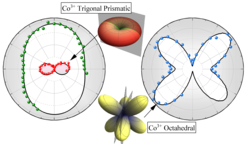Donut-shaped orbitals and Ising magnetism in Ca3Co2O6
Ca3Co2O6 is a very peculiar material. It shows stair-step jumps in the magnetization at regular intervals with an increasing applied field strength, which is indicative of the presence of quantum tunneling phenomena. Numerous theoretical and experimental studies have been carried out to explain the properties of Ca3Co2O6 and its close derivatives. These intriguing properties have their origin in the unusual arrangement of the atoms in this material type: one-dimensional chains are formed along the c-axis with alternating CoO6 octahedra and trigonal prisms, and in the ab-plane, the chains form a triangular-type lattice. The properties are then thought to arise from the geometrical frustration in the lattice and the presumed presence of Ising magnetism. However, it is not clear where this Ising magnetism comes from. All of the previous studies relied on calculations of one type or another, with varying and conflicting outcomes, depending on what theoretical approach was used.
Here, the Max-Planck/Cologne/Caen/Heidelberg team made use of a purely experimental method to determine the electronic state that is responsible for the Ising magnetism in Ca3Co2O6. The method is called “s-core-level non-resonant inelastic x-ray scattering” (s-NIXS). It is a very new method and is extremely powerful since it provides a direct image of the relevant local electronic orbital. The first publication about this method is given in Ref. 1. The s-NIXS experiments on Ca3Co2O6 have been performed at the P01 beamline at PETRA III at DESY by Brett Leedahl and colleagues. The results have now appeared in Nature Communications [2]. The orbital images obtained allowed for the unambiguous determination of the valence, spin, and orbital states for the two environments of Co ions present in the material. See Figure 1.
The octahedral Co ion has the 3+ low-spin t2g6 configuration and the prismatic trigonal Co the 3+ high-spin d6 state with the sixth electron occupying the d2 complex orbital that has the donut-like shape. This orbital carries a very large orbital moment of 2 mB, which provides a natural explanation for the Ising nature of Ca3Co2O6. It is quite remarkable that such an orbital occupation is stabilized in an oxide material. This has to do with the unusual coordination, namely prismatic trigonal, but even such a coordination will not guarantee the donut-shaped orbital to appear. Fine details in the interplay between the crystal structure and the various electronic degrees of freedom matter, and indeed, theory has great difficulties to explain reliably or even to predict the outcome due to the high accuracy needed. The fact that we are now able to experimentally determine the orbital state forms an important step towards a better understanding of the magnetic properties of Ca3Co2O6 and its derivatives.
[1] H. Yavaş, M. Sundermann, K. Chen, A. Amorese, A. Severing, H. Gretarsson, M.W. Haverkort, L.H. Tjeng, Nature Physics 15, 559 (2019), https://doi.org/10.1038/s41567-019-0471-2.
[2] B. Leedahl, M. Sundermann, A. Amorese, A. Severing, H. Gretarsson, L.-Y. Zhang, A.C. Komarek, A. Maignan, M.W. Haverkort, and L.H. Tjeng, Nature Communications (2019), 15, 559–562 (2019), https://doi.org/10.1038/s41467-019-13273-4.
BL, LHT / CPfS

